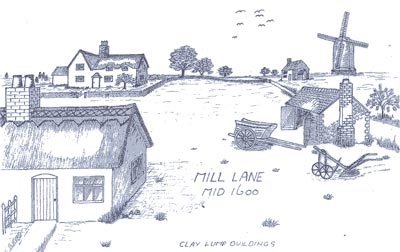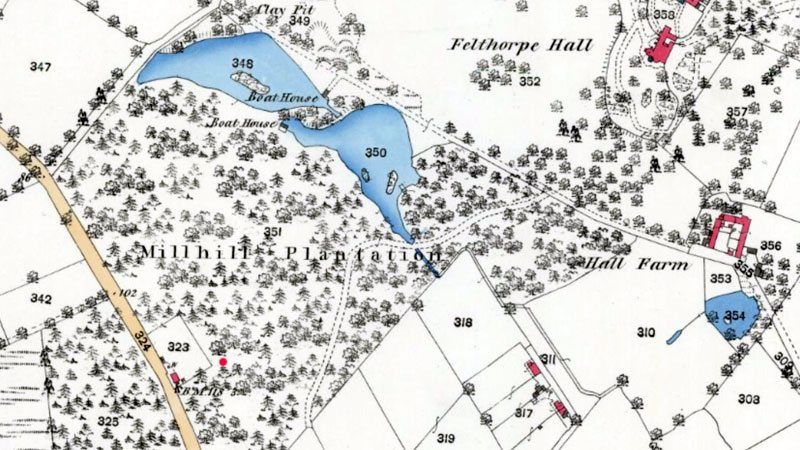
|
Felthorpe
Mill Hill postmill |
 |
Artist's impression of c.1650 by Andrew Bryan |
Felthorpe Mill Hill postmill had a roundhouse and powered 2 pairs of French burr stones and a flour mill. A large horse mill used for dressing flour was also on the site along with various outbuildings and a house that was almost certainly Mill Farmhouse that was only a few yards to the east. |
| Christopher West was almost certainly running Felthorpe Mill Hill post mill along with Felthorpe watermill prior to building the new Mill Farm postmill in the field opposite his farmhouse. The older Mill Hill postmill would have had common sails and an older design, whereas the new mill was built using up-to-date technology. |
To be Lett And entered upon at Michaelmas next in Felthorpe in the county of Norfolk. A Good accustomed WINDMILL in good Repair with two Pair of French Stones, a Flour Mill & Roundhouse & likewise a Dwelling House with 12 Acres of Arable Land all inclosed & entire together, with a Barn & Stable, a Cow house & also a large Horse Mill to dress Flour, situated on a good Common with a good Right of Commonage. For Particulars enquire of Robert Critoph. Norfolk Chronicle - 6th & 30th May 1775 |
Indenture - Bill of Sale 1. John Howlett of Brandisaton, farmer |
| A plaque on Mill Farm farmhouse is inscribed JS 1793 |
Sale of Farm at Felthorpe. |
Notice to Debtors & Creditors of |
I have a detailed map of Felthorpe printed in 1797, Mill Farm (built 1793) should be on that map but it’s not, the windmill on Mill Hill is shown very clearly, as it took several years from starting a survey to printing a map, I’m guessing that the survey was carried out before 1793. I know Elizabeth Springall married Christopher West in 1797 and then lived in Mill Farmhouse, Christopher West then became the miller at Felthorpe. It’s likely that Christopher West was using the Mill Hill windmill until the windmill on Mill Farm was built. I can’t find a date for the Mill Farm windmill being built but I would guess about 1820. I do know that the postmill was built at the peak of windmilling technology, it would have been a fine mill indeed but time was running out and the last date I can find for the windmill still working is 1908. That’s a very short working life for a windmill, it’s possible that it carried on in a limited way until the early 1900s. Andrew Bryan - September 2005 |
The son of Christopher (d.1847) emigrated to the US in 1833. He established himself in Baltimore, lived his entire life there, and never returned to England. Many of his family also stayed in Baltimore, as did mine. That is where I grew up. |
 |
Faden's map 1797 Mill Hill postmill upper centre right, marked Felthorpe Mill Felthorpe Watermill just to the west |
 |
O. S. Map 1882 Mill position marked by red dot, lower left Courtesy of NLS map images |
| May 1775: Mill advertised to be let Faden's map 1797: Felthorpe Mill 1809: Christopher West snr, miller May 1809: Mill Farm advertised for sale c.1819: Christopher West snr, miller - died 1819: Christopher West jnr, miller c.1820: Mill demolished |
| If you have any memories, anecdotes or photos please let us know and we may be able to use them to update the site. By all means telephone 07836 675369 or |
| Nat Grid Ref TG16201815 |
Copyright © Jonathan Neville 2005 |